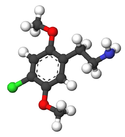
| |||
| |||
| Names | |||
|---|---|---|---|
| Preferred IUPAC name
2-(4-Chloro-2,5-dimethoxyphenyl)ethan-1-amine | |||
| Other names
(4-Chloro-2,5-dimethoxyphenethyl)amine
| |||
| Identifiers | |||
3D model (JSmol)
|
|||
| ChEMBL | |||
| ChemSpider | |||
PubChem CID
|
|||
| UNII | |||
CompTox Dashboard (EPA)
|
|||
| |||
| |||
| Properties | |||
| C10H14ClNO2 | |||
| Molar mass | 215.6778 g/mol | ||
| Melting point | 220 to 221 °C (428 to 430 °F; 493 to 494 K) (hydrochloride) | ||
| Pharmacology | |||
| Legal status |
| ||
Except where otherwise noted, data are given for materials in their standard state (at 25 °C [77 °F], 100 kPa).
| |||
2C-C is a psychedelic drug of the 2C family. It was first synthesized by Alexander Shulgin, sometimes used as an entheogen. In his book PiHKAL (Phenethylamines i Have Known And Loved), Shulgin lists the dosage range as 20–40 mg. 2C-C is usually taken orally, but may also be insufflated.[1] 2C-C is schedule I of section 202(c) of the Controlled Substances Act in the United States, signed into law as of July, 2012 under the Food and Drug Administration Safety and Innovation Act.[2]
Not much information is known about the toxicity of 2C-C.
- ^ Shulgin, Alexander; Shulgin, Ann (September 1991). PiHKAL: A Chemical Love Story. Berkeley, California: Transform Press. ISBN 0-9630096-0-5. OCLC 25627628.
- ^ "S. 3187: Food and Drug Administration Safety and Innovation Act, Subtitle D-Synthetic Drugs". FDA. June 27, 2012. Archived from the original on July 4, 2012. Retrieved July 12, 2012.

